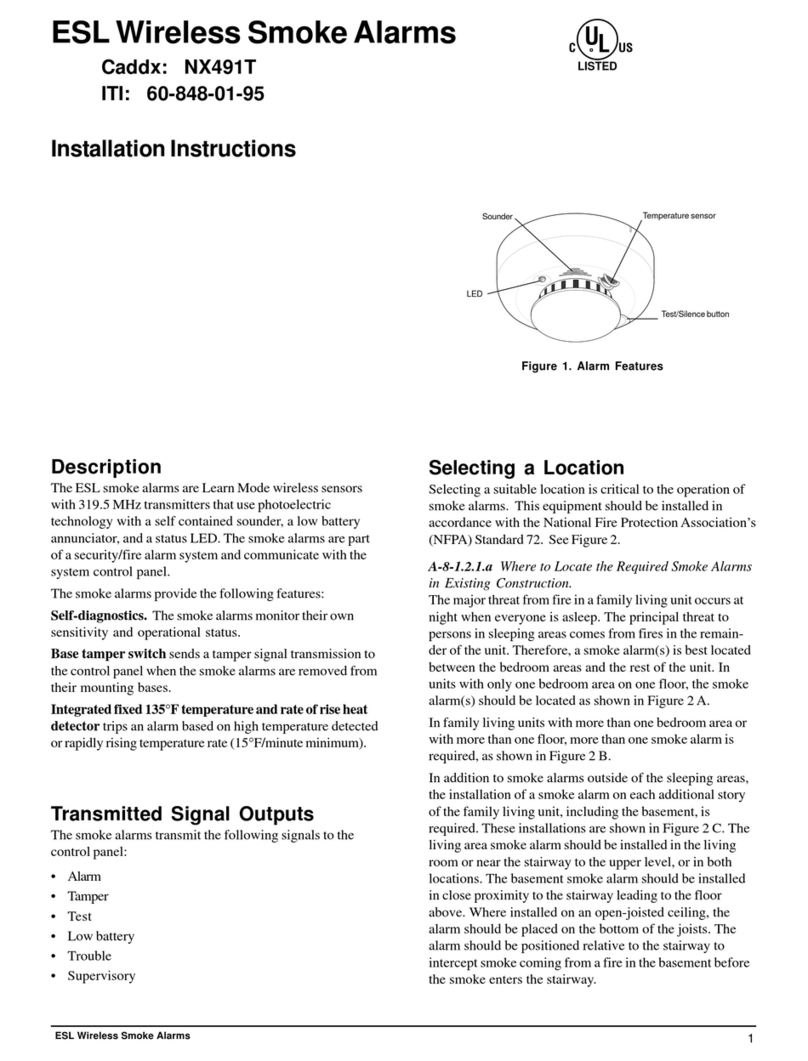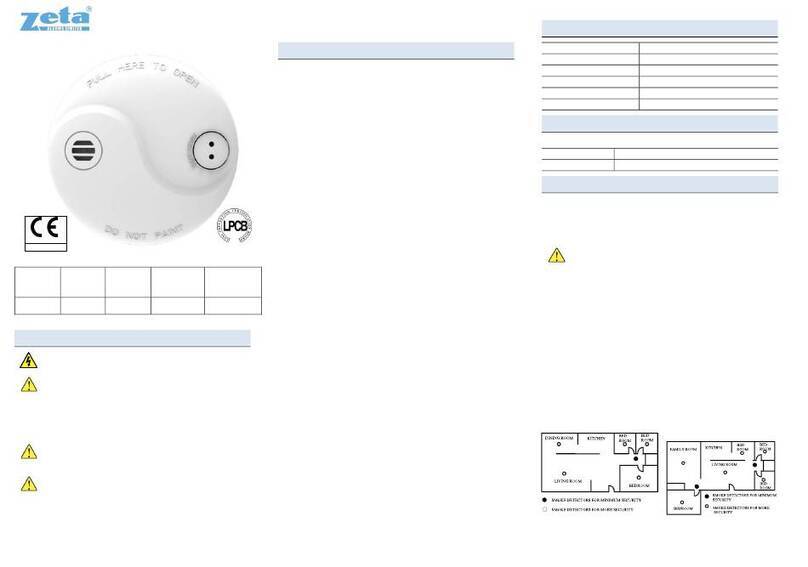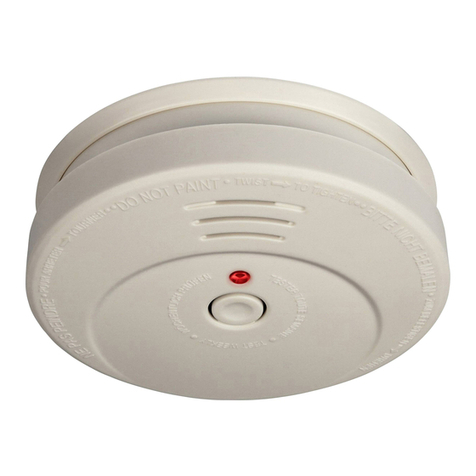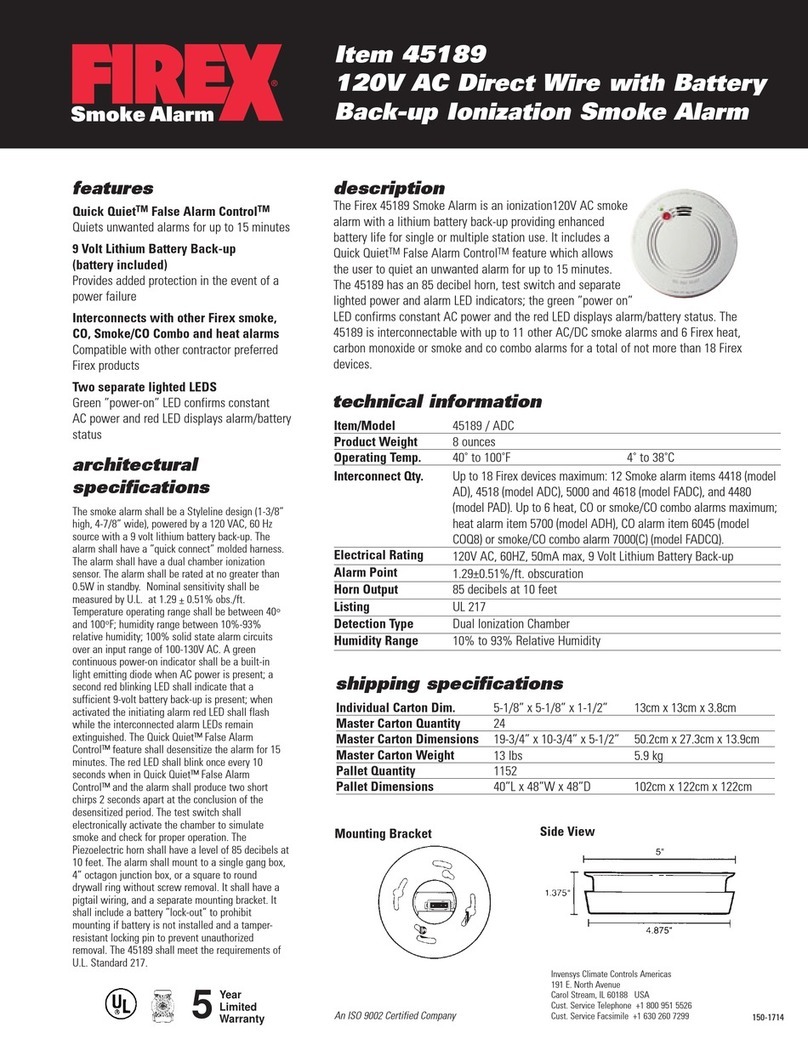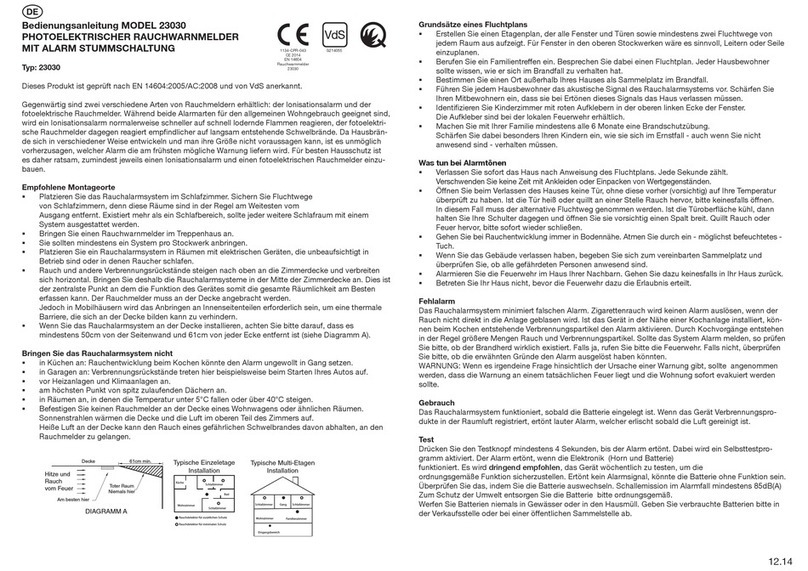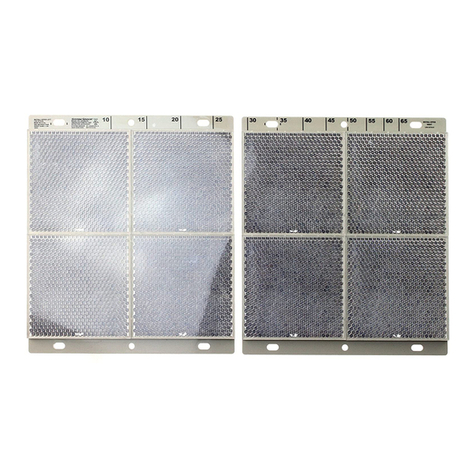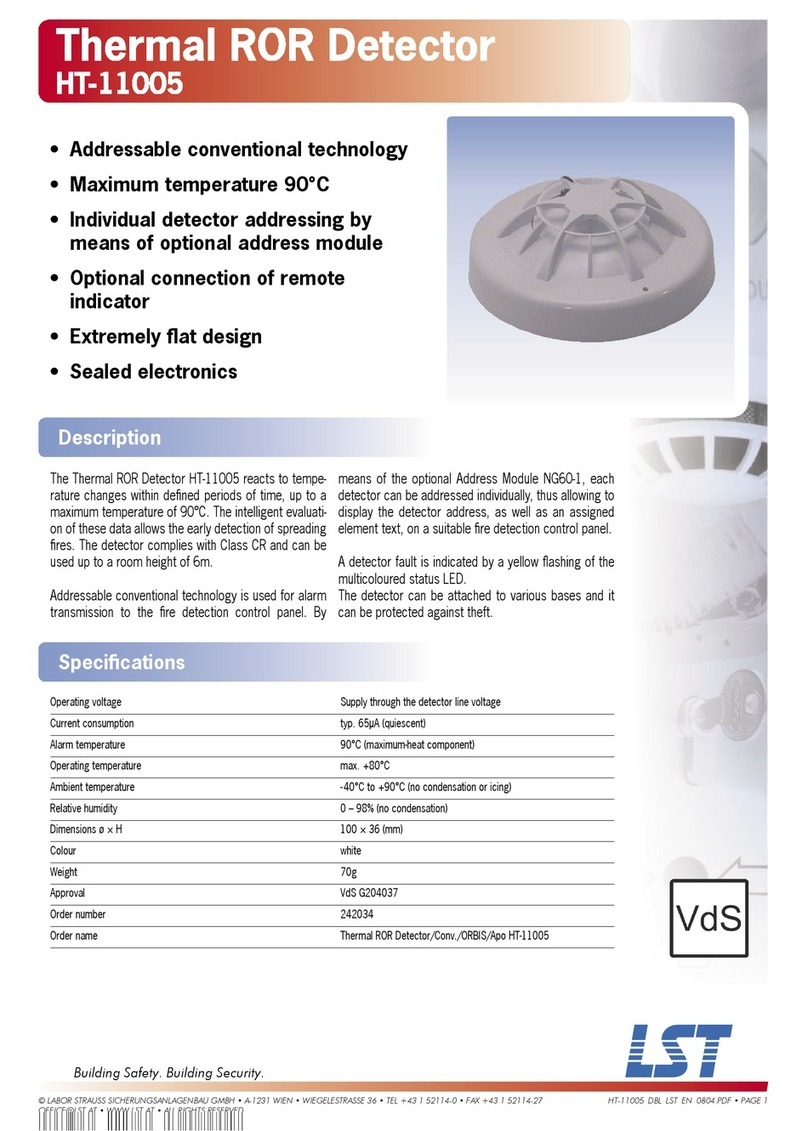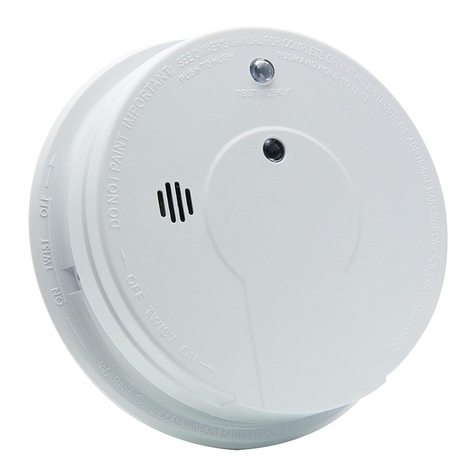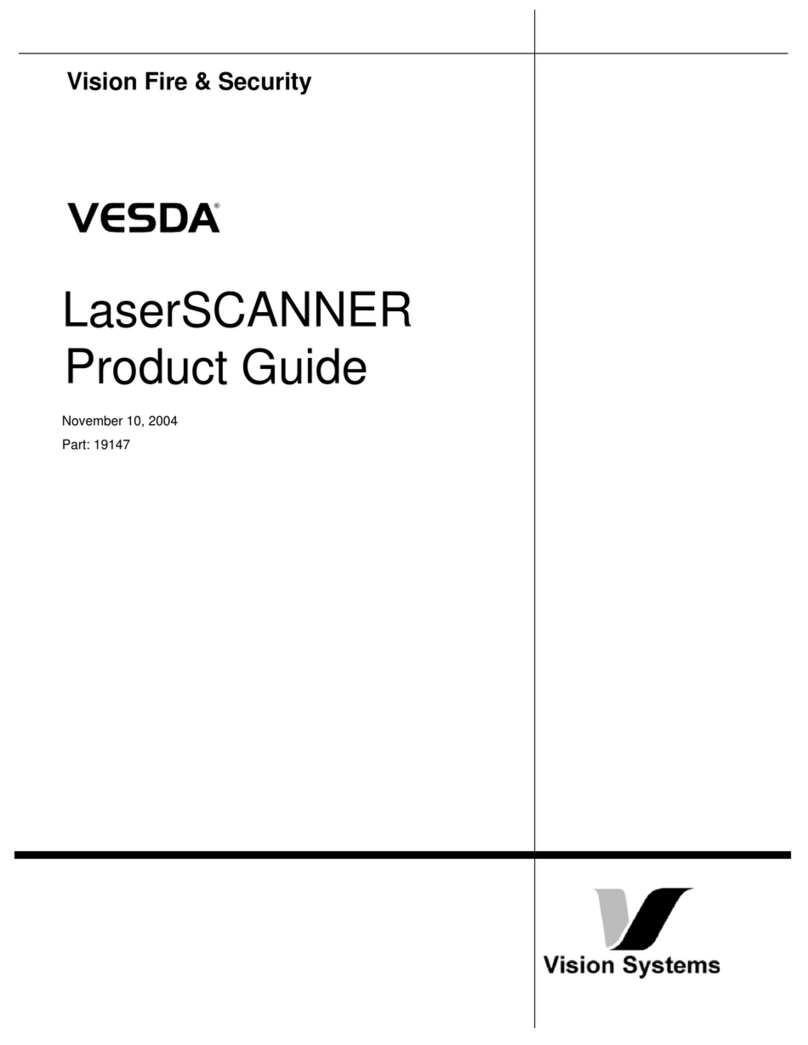Metasys 2412AT User manual

Fire Initiating Devices and Notification Appliances Technical Manual 408
Conventional Products Section
Technical Bulletin
Issue Date 1095
© 1995 Johnson Controls, Inc. 1
Code No. LIT-408155
Introduction Page 3
●
General Description 3
Installation Procedures 7
●
General Information 7
●
Mounting 7
●
Spacing 8
●
Wiring Installation Guidelines 8
●
Installation 9
●
Tamper-Proof Feature 10
Testing and Maintenance Procedures 11
●
Testing 11
●
Maintenance 13
●
Limitations of Smoke Detectors 15
●
Limitations of Sounders 16
2412AT, 2424AT, and 2424AIT
Direct 4-Wire Smoke Detectors

2 Conventional Products—2412AT, 2424AT, and 2424AIT Direct 4-Wire Smoke Detectors

Conventional Products—2412AT, 2424AT, and 2424AIT Direct 4-Wire Smoke Detectors 3
Introduction
This document contains important information about installing and
operating 2412AT, 2424AT, and 2424AIT direct wire smoke detectors.
These conventional detectors are manufactured by System Sensor for use
with Johnson Controls systems. If you install this detector for someone
else to use, you must leave a copy of this document with the user.
These instructions provide information regarding mounting, spacing,
wiring, installation, testing, and maintenance. Follow only those
instructions that apply to the model you are installing.
Before you install any 2412AT, 2424AT, and 2424AIT direct wire smoke
detectors, read and be familiar with:
●System Sensor Guide for Proper Use of System Smoke Detectors
Technical Bulletin in the Fire Initiating Devices and Notification
Appliances Technical Manual (FAN 408) that provides detailed
information on detector spacing, placement, zoning, wiring, and
special applications
●or, for non-United States installations, applicable codes and standards
specific to the country and locality of installation
Failure to follow these directions may result in failure of this device to
report an alarm or trouble condition or respond properly to an alarm
condition. Johnson Controls is not responsible for devices that have been
improperly installed, tested, or maintained by others.

4 Conventional Products—2412AT, 2424AT, and 2424AIT Direct 4-Wire Smoke Detectors
The 2412AT, 2424AT, and 2424AIT photoelectronic smoke detectors are
designed to provide open area protection and to be used with UL Listed
4-wire control panels.
The 2412AT operates at 12 VDC, and the 2424AT and 2424AIT operate
at 24 VDC. The sensor in this detector operates on the light scattering
principle and features a unique photo-optic sensing chamber that provides
good smoke entry while minimizing the effects of ambient light.
These detectors also provide restorable 135°F fixed-temperature heat
detection. The 2412AT and 2424AT heat detection unit is integrated
with the photoelectronic sensor while the 2424AIT’s heat detection
unit is isolated from the photoelectronic smoke sensor and can be
monitored separately.
In addition, a piezoelectric horn in each detector produces an interrupted,
85 dBA minimum tone when the individual detector alarms or when the
supply voltage polarity is reversed.
A Light Emitting Diode (LED) on each detector lights to provide a local
alarm indication and will remain on when the supply polarity is reversed.
A screw terminal is provided for a remote LED annunciator optional
accessory (RA400Z). These detectors are listed to UL 268 and are
latching-type system detectors. The alarm can be reset only by momentary
power interruption. For testing, these detectors have a test switch or may
be tested by inserting a calibrated test card in a test slot after removing the
detector’s cover.
Each detector contains one Form-A (SPST; NO) contact for connection to
an alarm-initiating circuit. Supervision of the detector power is
accomplished by installing a power supervisory End-of-Line (EOL) relay
module (A77-716B) at the end of the detector power circuit. When power
is applied to and through the detectors, the EOL power supervisory
module is energized. Its relay contacts close and provide a closed series
circuit in the control panel’s alarm Initiating Device Circuit (IDC).
A power failure or break in the detector power circuit de-energizes the
EOL module. The relay contacts open and trigger a trouble signal at the
control panel.
General
Description

Conventional Products—2412AT, 2424AT, and 2424AIT Direct 4-Wire Smoke Detectors 5
Table 1: 2400 Series Direct Wire Smoke Detectors
Model Configuration Description Operating Current Consumption
Voltage Standby
(Min) Alarm
(Max)
2400 2-wire Photo Detector 12/24 VDC 120 µA —
2400TH 2-wire Photo Detector with Fixed
Heat Sensor 12/24 VDC 120 µA —
2400AT 2-wire Photo Detector with Fixed
Heat Sensor and Horn 24 VDC 120 µA 67 mA
2400AIT 2-wire Photo Detector with
Isolated Heat Sensor 24 VDC 120 µA 67 mA
2412AT 4-wire Photo Detector with Fixed
Heat Sensor and Horn 24 VDC 120 µA 51 mA
2424AT 4-wire Photo Detector with Fixed
Heat Sensor and Horn 24 VDC 120 µA 43 mA
2424AIT 4-wire Photo Detector with
Isolated Heat Sensor and
Horn
24 VDC 120 µA 43 mA

6 Conventional Products—2412AT, 2424AT, and 2424AIT Direct 4-Wire Smoke Detectors
Table 2: Specifications Summary
Specifications
Diameter 5.5 in. (140 mm)
Height with Thermal 3.19 in. (81 mm)
Weight 0.7 lb (318 g)
Operating Temperature 32 to 100°F (0 to 38°C)
Operating Humidity 10 to 95% RH, Non-condensing
Air Velocity 3000 Ft/Min
Visual Indicator Solid-state LED
Latching Alarm Reset by Momentary Power Interruption
Audible Signal 85 dBA minimum interrupted tone when individual unit is in
alarm or when the supply voltage is reversed.
Electrical Ratings 2412AT 2424AT or 2424AIT
Operating Voltage 12 VDC 24 VDC
Full-wave, Unfiltered Full-wave, Unfiltered
Reset Voltage 0.73V 0.8V
Standby Current 120
µ
A Maximum 120
µ
A Maximum
Alarm Currents* 51 mA 43 mA
Reversed Supply 8 mA 15 mA
* Alarm is current limited. Add 7 mA Maximum with RA400Z Remote Annunciator LED.
Fixed Temperature Alarm
Point 135°F
Ripple 4V Peak-to-Peak
Startup Time 34 Seconds
Reset Time 0.3 Seconds
Relay-Characteristics One Form-A (SPST; NO) for Alarm Initiation
1.25 Ampere Contact at 30 VAC/DC Maximum Current

Conventional Products—2412AT, 2424AT, and 2424AIT Direct 4-Wire Smoke Detectors 7
Installation Procedures
This section contains installation information for 2412AT, 2424AT, and
2424AIT direct wire detectors. Instructions are given for mounting the
detector, and basic wiring information is provided.
!
CAUTION: Equipment hazard. Do not use in potentially
explosive atmospheres. Do not leave unused
wires exposed.
Each 2400 series detector is supplied with a mounting bracket kit that
permits it to be mounted in either of two ways:
• directly to a 3 or 4 inch (76.2 or 101.6 mm) octagonal, 1-1/2 inch
(38.1 mm) deep electrical box (Figures 1 and 2).
• to a 4 inch (101.6 mm) square electrical box using a plaster ring with
the mounting bracket kit supplied.
flmount2
Figure 1: Flush Mounting of Detector on 4 Inch Octagon Box
Tamper
Resistant Tab
mountbrk
To make detector tamper-proof,
break off tab extension at scribed line.
Figure 2: Detector Mounting Bracket
General
Information
Mounting

8 Conventional Products—2412AT, 2424AT, and 2424AIT Direct 4-Wire Smoke Detectors
NFPA-72-National Fire Alarm Code defines the spacing requirements for
smoke detectors. Typically, this is a maximum of 30 feet when the
detectors are installed on a smooth ceiling. However, all installations must
comply NFPA-72-National Fire Alarm Code and/or special requirements
of the authority having jurisdiction.
All wiring must be in compliance with the National Electrical Code, the
applicable local codes, and any special requirements of the local authority
having jurisdiction. Proper wire gauges should be used. The conductors
used to connect smoke detectors to control panels and accessory devices
should be color-coded to prevent wiring mistakes. Improper connections
can prevent a system from responding properly in the event of a fire.
For IDC wiring (the wiring between interconnected detectors as well as
the control panel), it is recommended that the wire be no smaller than
No. 18 American Wire Gauge (AWG) (1.0 square mm). However, the
screws and clamping plate in the base can accommodate wire sizes up to
No. 12 AWG (3.3 square mm).
For best system performance, the power (+) and (–) wires should be a
twisted pair and installed in a separate grounded conduit or shielded cable
to protect the IDC from extraneous electrical interference. If a cable shield
is provided, the shield connection to and from the detector must be
continuous by using wire nuts, crimping, or soldering as appropriate for a
reliable connection.
To make wire connections:
1. Strip about 3/8 inch of insulation from the end of the wire (use strip
gauge molded in base).
2. Slide the bare end of the wire under the clamping plate.
3. Tighten the clamping plate screw.
Note: Do not loop the wire under the clamping plate.
Figure 3: Class A or Class B Wiring Diagram for 2412AT and
2424AT Detectors used with 4-Wire Control Panels
Spacing
Wiring
Installation
Guidelines
2
78
21
3
78
smkwire5
Class A Return Loop
EOL Power
Supervision
Rela
y
Module
Su
g
g
ested
EOL
Resistor
Remote
Annunciator 1
3
Power to
Detectors
UL Listed
Control
Panel
Initiatin
g
Loop
(IDC)

Conventional Products—2412AT, 2424AT, and 2424AIT Direct 4-Wire Smoke Detectors 9
Figure 4: Additional Wiring Needed for the Isolated Thermal Unit
of the 2424AIT Detector
Note: Thermal units may be wired to a separate IDC.
!
WARNING: Shock hazard. Disable the power IDCs before
installing detectors.
1. Wire each detector following installation guidelines.
2. Line up arrows on the detector with arrows on the mounting bracket.
3. Turn the detector clockwise until it clicks into place.
4. Enable the tamper-proof feature. For instructions see the
Tamper-Proof Feature section of this technical bulletin.
5. After all detectors have been installed, apply power to the control unit.
6. Test the detector as described in the Testing section of this
technical bulletin.
7. Reset the detector at the system control panel.
8. Notify the proper authorities that the system is in operation.
Dust covers are an effective way to limit the entry of dust into smoke
detector sensing chambers. However, they may not completely prevent
airborne dust particles from entering the detector. Therefore, remove
detectors before beginning construction or other dust producing activity.
Be sure to remove dust covers from any sensors that were left in place
during construction as part of returning the system to service.
smkwire6
4Su
g
g
ested
EOL
Resistor
5
UL Listed
Two or
Four
Wire
Panel
Initiatin
g
Loop
(
IDC
)
45
Installation
Limiting
Exposure to Dust

10 Conventional Products—2412AT, 2424AT, and 2424AIT Direct 4-Wire Smoke Detectors
This detector includes a tamper-proof feature that, when activated,
prevents removal of the detector without the use of a tool.
To activate this feature:
1. Cut off the smaller tab at the scribed line on the tamper-proof tab
located on the detector mounting bracket (Figure 2).
2. Install the detector.
To remove the detector from the bracket once the tamper-proof feature has
been activated:
1. Depress the tamper-proof tab located in the slot on the mounting
bracket.
2. Turn the detector counterclockwise for removal.
The tamper-proof feature may be defeated by breaking and removing
the plastic lever from the base. However, this prevents using the
feature again.
Tamper-Proof
Feature

Conventional Products—2412AT, 2424AT, and 2424AIT Direct 4-Wire Smoke Detectors 11
Testing and Maintenance
Procedures
Before testing, notify the proper authorities that the smoke detector system
is undergoing testing and will temporarily be out of service.
Detectors must be tested after installation and periodic maintenance.
After a detector is set into alarm by one of the following test methods, and
the alarm activating device is removed from the detector, the system
should be reset at the control panel before testing any additional detectors.
After all testing is complete, notify the proper authorities the system is
back in service.
testswc3
Test Module
Socket
LED
Push recessed test switch
with a 0.1 inch Max. Diameter tool.
Recessed
Test Switch
Figure 5: Bottom and Side Views
Showing Position of Test Switch
Before testing the detector, check for the presence of the flashing LED
after the power is applied to the IDC or power circuit. If it does not flash,
power has been lost to the detector (check the wiring), or it is defective
(return for repair).
Recessed Test Switch
1. Push and hold the recessed test switch with a 0.1 inch maximum
diameter tool.
2. The LED should latch within five seconds indicating alarm and
annunciating the panel.
3. The horn should also sound.
Testing
Testing the
2412AT, 2424AT,
and 2424AIT

12 Conventional Products—2412AT, 2424AT, and 2424AIT Direct 4-Wire Smoke Detectors
Calibrated Test Card (R59-18-00)
1. Remove the detector cover by placing a small-bladed screwdriver in
the side slot of the detector cover.
2. Twist it slightly until the cover can be turned counterclockwise for
removal.
3. Insert the NO ALARM end of the test card fully into the test slot
(Figure 6).
4. Slide it counterclockwise until it stops.
5. Wait at least 20 seconds, and the detector should not alarm.
6. Remove the test card by sliding it clockwise before removing, then
repeat with the ALARM end of test card.
7. The LED should latch on within 20 seconds indicating alarm and
annunciating the panel.
8. Put the cover back by gently rotating it clockwise until it locks
in place.
Sensitivity Test Module (MOD400R or MOD400)
The MOD400R or MOD400 is used with an analog or digital voltmeter to
check the detector sensitivity as described in the test module manual.
If the detector’s sensitivity limits or the MOD400R limits do not appear on
the back of the detector, the MOD400R is not suitable for field sensitivity
testing of that unit.
Aerosol Generator (Gemini 501)
1. Set the generator to represent 4%/ft to 5%/ft obscuration as described
in the Gemini 501 manual.
2. Using the bowl-shaped applicator, apply aerosol until unit alarms.
Direct Heat Method (Hair dryer of 1000–1500 watts)
1. Direct the heat toward the bimetallic collector.
2. Hold the heat source about 12 inches from the detector in order to
avoid damage to the plastic.
3. When the heat rises to greater than 135°F, the detector should latch
in alarm.
4. The detector will reset only after it has had sufficient time to cool and
the power source has been momentarily interrupted.
Detectors that fail these tests should be cleaned as described in the
Maintenance section of this technical bulletin and retested. If the detectors
still fail these tests, they should be returned for repair.

Conventional Products—2412AT, 2424AT, and 2424AIT Direct 4-Wire Smoke Detectors 13
Before cleaning, notify the proper authorities that the smoke detector
system is undergoing maintenance and will be temporarily out of service.
Disable the system undergoing maintenance to prevent unwanted alarms.
After maintenance is performed on a detector, it should be functionally
tested to assure proper operation.
1. Remove the detector cover by placing a small-bladed screwdriver in
the side slot of the detector cover.
2. Twist it slightly until the cover can be turned counterclockwise
for removal.
3. Vacuum the screen carefully without removing it.
If further cleaning is required continue with Step 4, otherwise skip to
Step 9.
4. Remove the screen by pulling it straight out.
5. Vacuum the inside.
6. Clean the vaned chamber piece by vacuuming out dust and particles.
7. To replace the screen, orient it so that the arrow on top aligns with the
field test socket on the detector.
8. Carefully push the screen into place, making sure it fits tightly to
the chamber.
9. Replace the cover by gently rotating it clockwise until it locks
in place.
Maintenance

14 Conventional Products—2412AT, 2424AT, and 2424AIT Direct 4-Wire Smoke Detectors
covscr5
Removable
Head Cover
Cleanable Screen .....
(P/N RS24T) .....
Test Slot
Removal Slot
Figure 6: Removal of Cover and Screen for Cleaning

Conventional Products—2412AT, 2424AT, and 2424AIT Direct 4-Wire Smoke Detectors 15
This smoke detector is designed to activate and initiate emergency action,
but will do so only when used in conjunction with other equipment.
This detector is designed for installation in accordance with NFPA
Standard 72-National Fire Alarm Code.
●Smoke detectors will not work without power. Alternating Current
(AC) or Direct Current (DC) powered smoke detectors will not work
if the power supply is cut off for any reason.
●Smoke detectors will not sense fires that start where smoke does not
reach the detectors. Smoke from fires in chimneys, in walls, on roofs,
or on the other side of closed doors may not reach the smoke detector
and alarm it.
●A detector may not detect a fire developing on another level of a
building. For this reason, detectors should be located on every level
of a building.
●Smoke detectors have sensing limitations. Ionization detectors offer
broad range fire-sensing capability, but they are better at detecting
fast, flaming fires than slow, smoldering fires. Photoelectronic
detectors sense smoldering fires better than flaming fires. Because
fires develop in different ways, and are often unpredictable in their
growth, neither type of detector is always best, and a given detector
may not always provide warning of a fire. In general, detectors
cannot be expected to provide warnings for fires resulting from
inadequate fire protection practices, violent explosions, escaping gas,
improper storage of flammable liquids like cleaning solvents, other
safety hazards, or arson.
This detector is UL Listed to operate in a maximum air velocity of
3000 ft/min. Air velocity, along with other factors, may affect
detector sensitivity. See the 1993 NFPA-72-National Fire Alarm
Code, Appendix B for information.
●Test your smoke detector system per NFPA 72-National Fire Alarm
Code, or codes and standards specific to the country of installation, at
least semiannually. Clean and take care of your smoke detectors
regularly.
Limitations of
Smoke
Detectors

16 Conventional Products—2412AT, 2424AT, and 2424AIT Direct 4-Wire Smoke Detectors
The sounder in this detector may not work if the power is cut off for
any reason.
●The sounder may not be heard. The loudness of the sounder meets or
exceeds current Underwriters Laboratories (UL) standards. However,
the sounder may not alert a sound sleeper, one who has recently used
drugs, or one who has been drinking alcoholic beverages. The
sounder may not be heard if it is placed in an area which is isolated by
a closed door, located on a different floor from the person in hazard,
or placed too far away to be heard over the ambient noise such as
traffic, air conditioners, machinery, or music appliances that may
prevent alert persons from hearing the alarm. The sounder may not be
heard by persons who are hearing impaired.
Limitations of
Sounders
Controls Group FAN 408
507 E. Michigan Street Fire Initiating Devices and Notification Appliances Technical Manual
P.O. Box 423 Printed in U.S.A.
Milwaukee, WI 53201
This manual suits for next models
2
Table of contents
Other Metasys Smoke Alarm manuals

Metasys
Metasys 2251J User manual
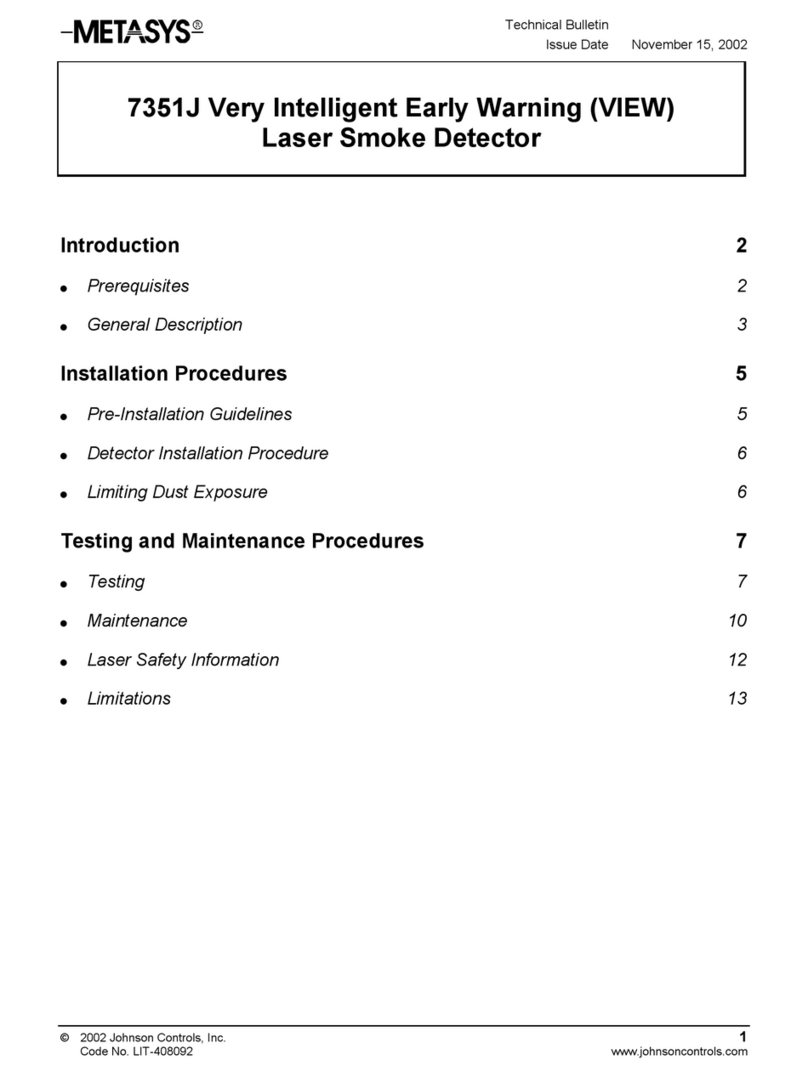
Metasys
Metasys 7351J Service manual

Metasys
Metasys DH400 User manual

Metasys
Metasys 1551J User manual
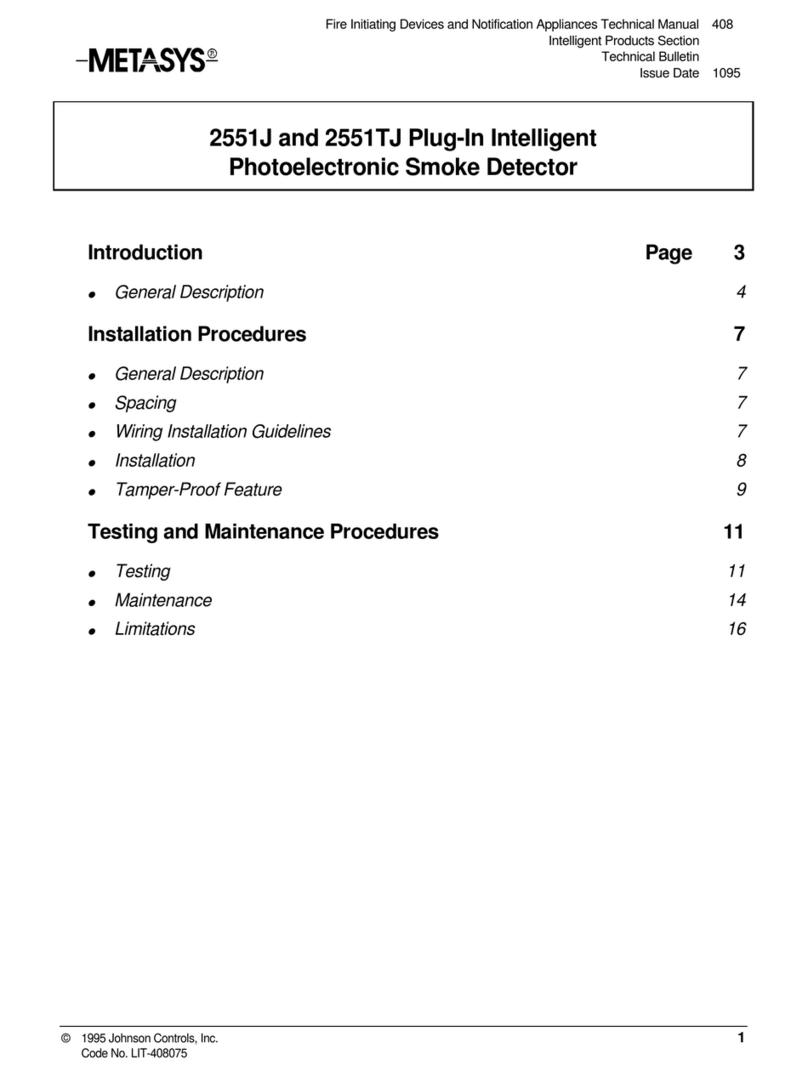
Metasys
Metasys 2551J User manual
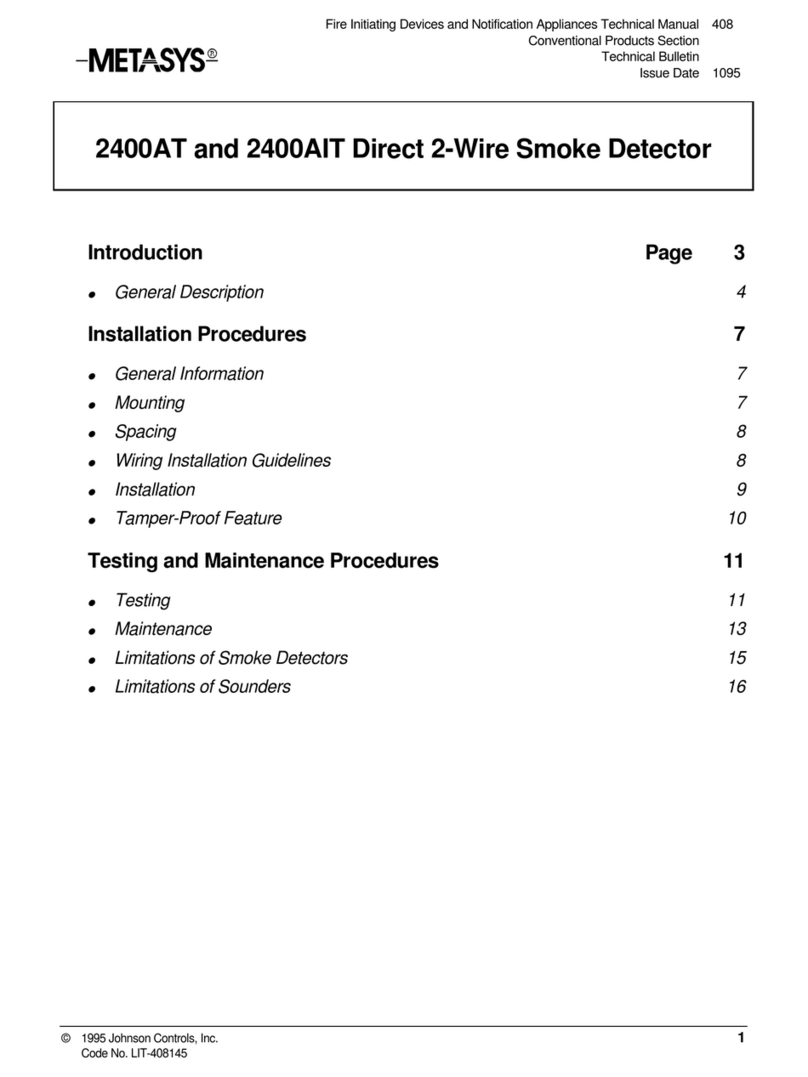
Metasys
Metasys 2400AT Service manual

Metasys
Metasys 6424 User manual

Metasys
Metasys 1400 User manual
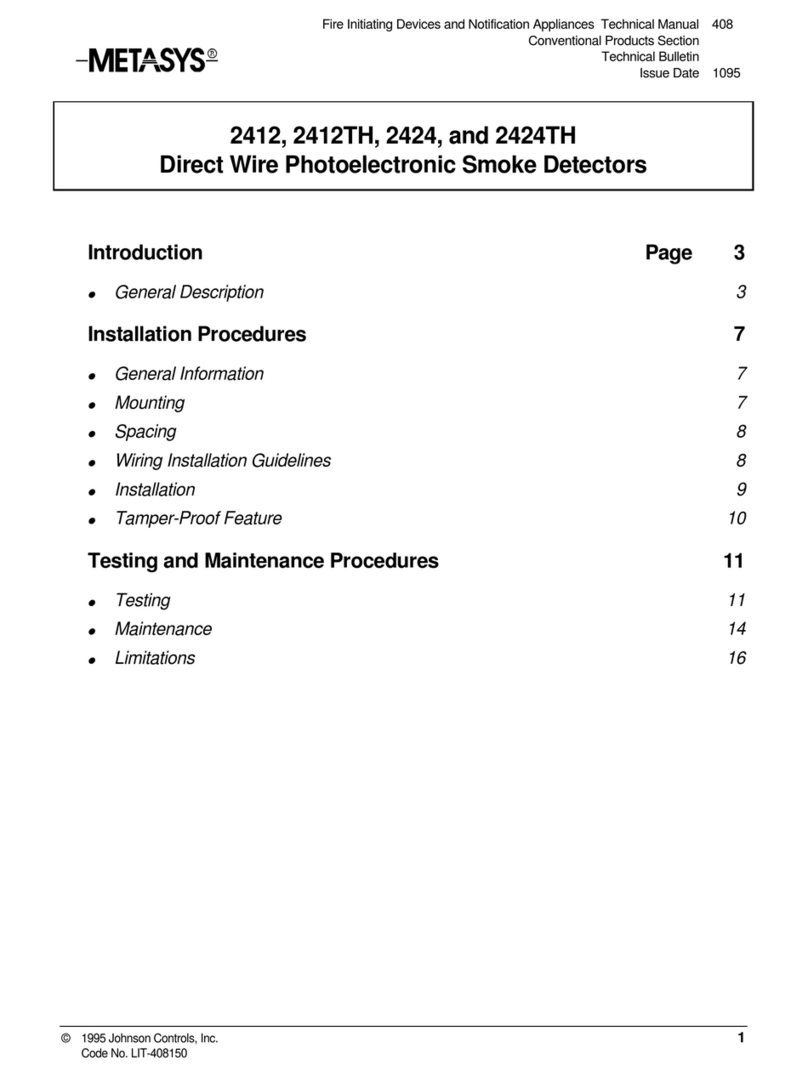
Metasys
Metasys 2412 Series Service manual
Popular Smoke Alarm manuals by other brands

Vesta
Vesta SD-29-SC-AC Series quick start guide
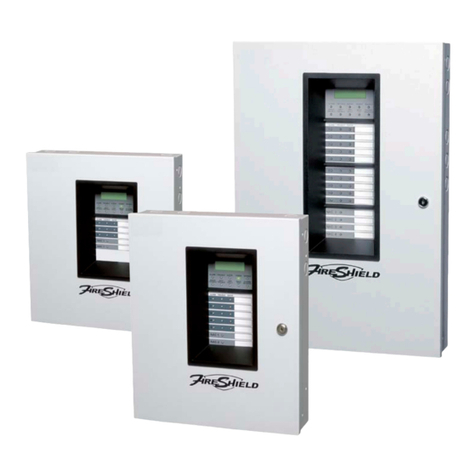
GE Security
GE Security FireShield FS302 Technical reference manual
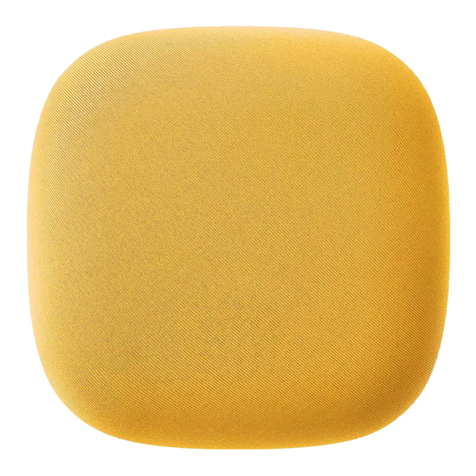
Jalo Helsinki
Jalo Helsinki Kupu manual
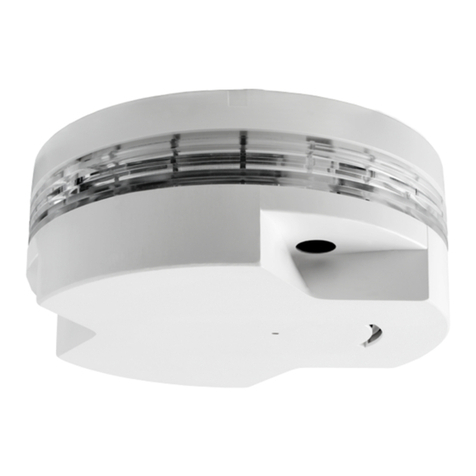
QUNDIS
QUNDIS Q smoke 5.5R Installation and operating instructions
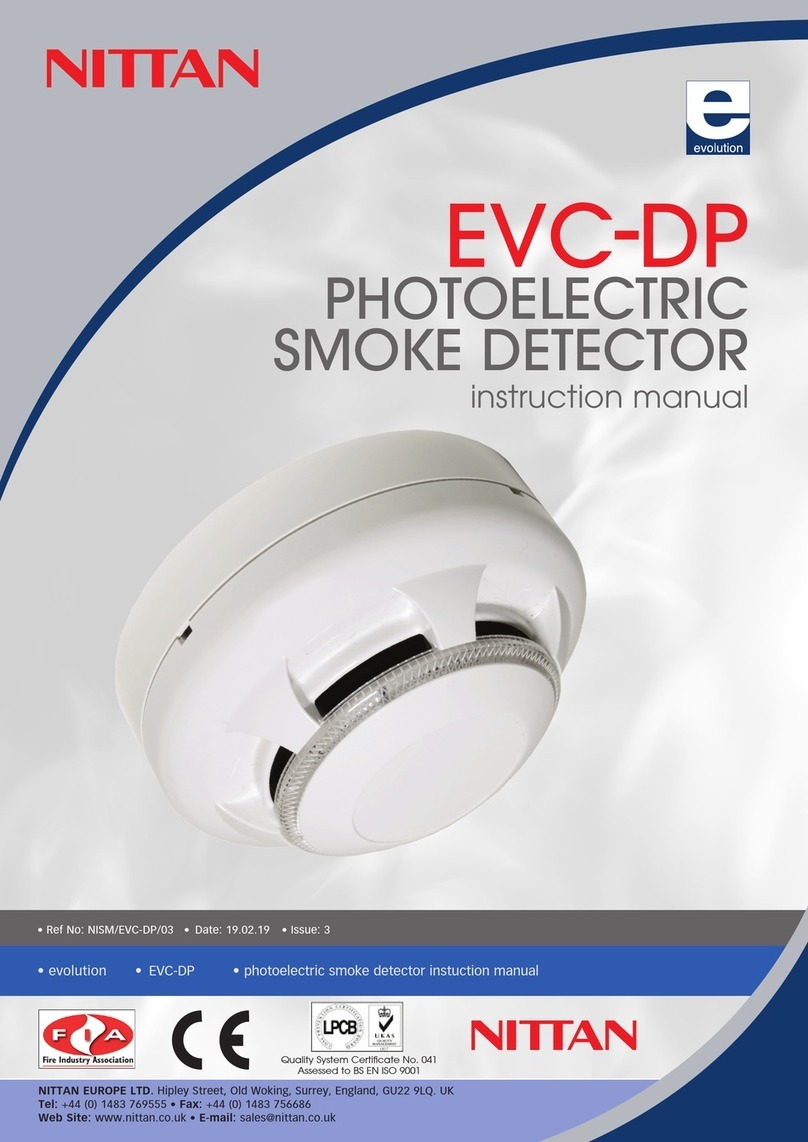
Nittan
Nittan Evolution EVC-DP instruction manual
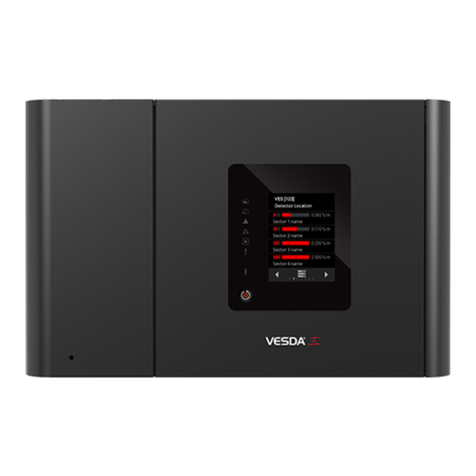
Xtralis
Xtralis VESDA Commissioning Guide
